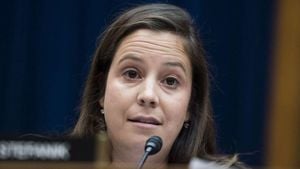Donald Trump's vision for the American education system has sparked significant debate, especially with his recent pledge to eliminate the U.S. Department of Education. This proposal was not just thrown out on the campaign trail; it’s rooted in decades of conservative ideology aimed at reducing federal oversight of schools.
During his campaign, Trump expressed his desire to dismantle what he described as the "government education swamp," which he claims indoctrinates American youth and wastes taxpayers’ dollars. "I say it all the time, I’m dying to get back to do this. We will eliminate the federal Department of Education," Trump stated emphatically at a rally, signaling his intention to fundamentally change the structure of the nation's educational system.
The Department of Education, established as a Cabinet-level agency by President Jimmy Carter in 1979, has played pivotal roles such as distributing federal funds to K-12 schools and overseeing federal student loan programs. Trump’s proposal raises significant questions about the future of these programs and the regulatory functions the department carries out.
Some of the department's most important functions include managing programs like Title I, which provides financial assistance to schools serving low-income students, and the Individuals with Disabilities Education Act (IDEA), which supports special education services. Together, these programs account for around $28 billion annually, ensuring access to quality education for many underserved children. Eliminaring the department would likely cut off this flow of funding or leave it to the whims of state legislatures.
Education Secretary Jacob Oliva from Arkansas has weighed in, arguing the potential benefits of such elimination, especially for states like Arkansas. He articulated hope for continued federal funding without the cumbersome bureaucratic restrictions often tied to it. "The desire is to receive federal funding without the red tape and strings attached," he explained emphatically, underlining how states could benefit from increased autonomy.
Despite these optimistic views, many educators and experts warn against the immediate fallout from such moves. Federal funding accounts for only about 10% of total school revenue, meaning states and localities would have to heavily compensate for any shortfall, especially for programs supporting low-income families and disabled students.
Efforts to abolish the department would necessitate significant legislative action. Trump’s first term proposal, which aimed to merge the Education Department with the Labor Department, similarly found no traction. This historical pushback indicates deep-rooted challenges to any significant reform efforts.
Critics of the Department of Education are often vocal about the regulations they ascribe to it. They argue it creates red tape, which complicates funding and implementation of educational policies. Nevertheless, advocates for the department argue such oversight is necessary to maintain standards and equity across schools. The department, through its Office of Civil Rights, investigates discrimination complaints and works to enforce laws ensuring equal access to education. Removing this oversight could regress progress made particularly for marginalized communities.
And then there's the question of funding. Trump's strategy appears to be focused on converting federal programs like Title I and IDEA funding from their current forms to block grants. This shift could weaken accountability and oversight, making it easier for funds to be redirected to other uses, such as school vouchers. Critics argue this could undermine the quality of education provided to the most vulnerable populations.
Abolishing the Department of Education may not mean the end of federal education funding, but it could drastically reshape how these funds are allocated and utilized. Programs have historically existed outside the department, and there's speculation as to whether they could merely be shifted to different federal agencies. Still, there are significant hurdles to overcome, as any such move would require negotiation and consensus within Congress.
While some members of Congress may align with Trump’s vision, debates about the future structure of education funding suggest anything but smooth sailing. Past efforts to downsize the department or integrate it with other agencies have been met with resistance not only from Democrats but also from Republicans, particularly those who value federal education funding and the support it offers.
Trump's proposal reveals broader ideological divides within the political arena about the role of federal government versus state control. The tension between local leadership and federal oversight has long reached peak levels during times of national crisis. During the COVID-19 pandemic, for example, Trump’s inability to compel local districts to comply with federal guidelines demonstrated the limits of federal authority, making it apparent how much power remains with states and local governments.
The discussion around the potential dismantling of the Department of Education encapsulates not just educational philosophy but broader discussions about civil rights, equality, and state rights. Those against Trump’s proposal see it as paving the way for increased inequality, particularly affecting students from low-income backgrounds and those requiring special education services.
Trump’s supporters may cheer such drastic changes as efforts to re-empower local communities and reduce wasteful federal steps, yet detractors warn of the immediate impacts on some of the most vulnerable populations. For many, the stakes are incredibly high as they look toward the future of education should Trump regain control.
Whatever the outcome of Trump’s plans, abolishing the Department of Education raises questions about accountability, funding, and access to quality education—a combination of factors already fraught with tension in today’s polarized political environment. Whether Congress will align with Trump's views remains uncertain, as this will require the complex maneuvering of interests deeply rooted on both sides of the aisle.



